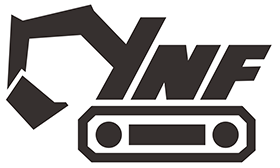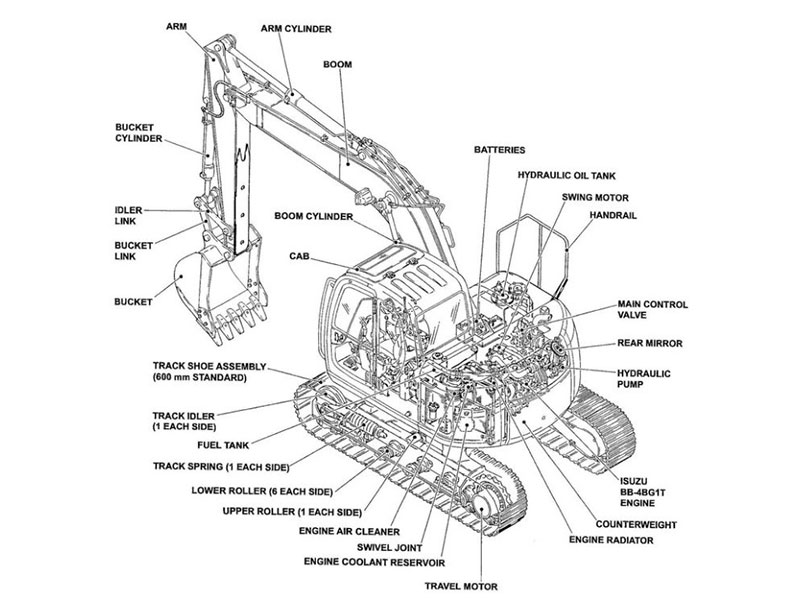
Excavators are powerful machines designed for construction and digging tasks. The parts of an excavator machine work seamlessly together to ensure optimal performance. Each component, such as the engine and tracks, plays a crucial role in providing precision and stability. For instance, one excavator equipped with three 1M2P MCCs achieved an impressive 73.3% efficiency during operation, highlighting the effectiveness of its parts working in harmony. The boom, arm, and bucket are essential parts of an excavator machine, combining to deliver the strength and control needed for digging. Proper maintenance of these parts ensures the machine operates efficiently and extends its lifespan.
Key Takeaways
Excavators use a strong engine to turn fuel into energy. This helps them do many tasks quickly and easily.
Hydraulic systems help move the boom, arm, and bucket. These parts are used for digging and lifting with accuracy.
Taking care of hydraulic systems, like changing the oil, keeps them working well and makes the excavator last longer.
How well an operator handles the machine affects its performance. Training can help operators work better and avoid damage.
Checking the tracks and undercarriage every day is important. This keeps the excavator steady and able to move on all surfaces.
The Engine: Powering the Excavator
Creating Energy for Excavator Tasks
The engine is like the excavator’s heart, giving it power. It changes fuel into energy to run the machine’s main systems. Depending on the type, an engine can make 50 kW to over 500 kW of power. This range helps excavators handle small or big jobs, like digging or moving heavy dirt.
Newer engines meet strict pollution rules, like Euro Stage IV/V and Tier 4 Final. They use special tech, such as Exhaust Gas Recirculation (EGR) or Selective Catalytic Reduction (SCR). These features improve performance and lower harm to the environment.
Feature | Information |
|---|---|
Power Range | From 50 kW to over 500 kW |
Pollution Standards | Euro Stage IV/V, Tier 4 Final with EGR or SCR |
The engine gives steady energy, helping the excavator work well, even in tough conditions.
Helping Hydraulic Systems Move
The engine powers the hydraulic systems that make the excavator move and work. A medium-sized excavator engine often has an 8.3-liter size and makes up to 350 horsepower. It powers pumps that move 150 gallons of fluid per minute at 4,500 psi.
Pumps turn the engine’s energy into hydraulic energy.
Motors use this energy to move tracks, so the excavator can travel on different surfaces.
The hydraulic system also moves the boom, arm, and bucket for smooth digging.
Without the engine, the hydraulic system wouldn’t have enough energy to work. This teamwork between the engine and hydraulics keeps the excavator strong and useful.
Hydraulic Systems: The Core of Excavator Functionality
Powering the Boom, Arm, and Bucket
The hydraulic system is key to how an excavator works. It powers the boom, arm, and bucket to lift and dig. Hydraulic cylinders are important for this. They turn hydraulic energy into force, helping the machine move materials easily.
Hydraulic pumps create pressure that powers the cylinders. For example, when you lift the boom, fluid flows into its cylinders. This creates the force needed to raise it. This smooth energy transfer helps the excavator work well, even with heavy loads.
Studies show how efficient hydraulic systems can be. One study by Xia et al. showed energy use dropped by 50% by reusing energy when lowering the boom. Another study by Zimmerman et al. found fuel use could drop by 40% by reducing energy waste. These improvements make excavators better for the environment.
Study | Findings |
|---|---|
Xia et al. | Saved 50% energy by reusing energy during boom lowering. |
Zimmerman et al. | Cut fuel use by 40% by reducing energy waste. |
Lin et al. | Found 260.4 kJ energy savings in one work cycle. |
Taking care of the hydraulic system is very important. Changing oil and filters every 2,000–3,000 hours keeps it clean and working well. Using better hydraulic oil can save 5% more energy, making the system even more reliable.
Enabling Smooth Coordination Between Components
The hydraulic system not only moves parts but also keeps them working together. This teamwork is needed for accuracy and balance during work. Hydraulic motors and cylinders help the excavator do tough jobs easily.
For example, when digging, the system powers the boom, arm, and bucket at the same time. This lets the excavator dig at the right angles and depths. It can stay accurate within 3 cm, helping you avoid mistakes.
Metric | Value |
|---|---|
Accuracy | Within 3 cm |
Thresholds for machine forces | ~6,000 N |
Maximum end-effector forces | 55,000 N |
The tracks, part of the undercarriage, also use the hydraulic system. Hydraulic motors move the tracks, letting the excavator travel on different surfaces. This connection between the system and tracks keeps the machine steady, even on uneven ground.
Strong hydraulic parts make the system more reliable. Good materials and designs can cut part failures by 30%. This lowers repair costs and keeps the machine running longer. Using high-quality cylinders and motors ensures smooth and efficient operation.
Tip: Check the hydraulic system often for leaks or damage. Fixing problems early can save money and keep your excavator working longer.
Boom, Arm, and Bucket: Key Parts of Excavator Machine
Jobs of the Boom, Arm, and Bucket
The boom, arm, and bucket are main parts of an excavator. They work together to dig, lift, and move materials with accuracy. The boom gives height to place the arm and bucket. The arm stretches out from the boom for flexible movement. The bucket scoops, digs, and carries things like dirt or sand.
Each part has its own job. The boom raises and lowers the arm to reach different levels. The arm moves sideways to push or pull the bucket. The bucket cuts into the ground and carries materials like gravel or clay. These parts work as a team to help the excavator do its tasks well.
Technology helps these parts work better. Sensors track how the boom, arm, and bucket move. Other sensors check the forces at joints to make sure everything works smoothly. This tech helps the excavator handle tough jobs and stay efficient.
Accurate Digging and Depth Control
The boom, arm, and bucket help the excavator dig with precision. The boom changes its angle to set the bucket’s depth. The arm keeps the bucket steady for accurate digging. The bucket’s sharp edges cut into the ground at the right angles.
Studies show how these parts improve digging. For example, the boom lowers to reach deeper spots, while the bucket adjusts to cut soil. This teamwork gives the excavator strong digging power. The bucket is key for breaking through tough ground.
Tests prove these parts work well. Over 18 months, excavators dug up to 2 meters deep and swung between 60° and 120°. They worked well with sand, clay, and gravel. Both skilled and new operators got good results, showing how reliable these parts are.
Special tools measure angles and movements for accuracy. Sensors on the boom and arm give real-time data. Other sensors check the tilt of parts to improve depth control. These tools keep the excavator precise, even in hard conditions.
Tip: Check the boom, arm, and bucket often for damage. Fix or replace worn-out parts quickly to keep the excavator working well.
Tracks and Undercarriage: Stability and Mobility
How Tracks Help the Excavator Move
Excavator tracks are important for moving on different surfaces. They help the machine travel over rough ground, mud, and steep areas. Tracks keep the excavator steady and prevent slipping in tough conditions.
Check tracks daily to keep them working well. Look for damage, dirt, or worn-out treads. Every week, inspect the track frame and undercarriage parts closely. This helps find problems early and keeps the machine running smoothly. Telematics systems can show real-time data like fuel use and hours worked. Watching this data helps you fix issues before they cause delays.
Tracking performance can show signs of problems. By studying the data, you can fix small issues before they get worse. This keeps the tracks strong and the excavator reliable during work.
Holding Weight and Staying Balanced
The undercarriage supports the excavator’s weight and keeps it balanced. Carrier rollers spread the weight evenly on both sides of the track frame. This stops the crawler from rubbing directly on the ground, which reduces damage.
Carrier rollers also guide the tracks to stay on their path. They absorb shocks from bumpy ground, protecting the machine’s parts from wearing out too fast. This design helps the excavator stay balanced, even on steep or uneven surfaces.
Studies show how weight and balance are important for safety. Engineers use 3D models and tests to see how the undercarriage works. These tests show how the track frame helps the excavator stay stable and carry its weight safely.
Tip: Clean the track frame often and check carrier rollers for damage. Regular care keeps the excavator working well and lasting longer.
Operator Controls: Managing Excavator Harmony
How Operator Commands Coordinate Components
Operator controls act as the brain of the excavator. They help you manage all parts with ease and accuracy. Modern excavators have advanced systems to simplify control of the boom, arm, bucket, tracks, and hydraulics. These systems ensure all parts work together smoothly for the best results.
Joysticks and pedals are the main controls. They turn your commands into actions. For example, pushing the joystick forward makes the arm extend. Pulling it back makes the arm retract. This connection between controls and parts allows easy digging, lifting, and moving.
Tests show how good controls improve performance. Operators using newer systems worked faster and more efficiently. Surveys also showed that operators found these controls easier and more reliable to use.
Parameter Type | Description | Outcome |
|---|---|---|
Usability Testing | Old joystick control vs. new coordinated control system | Better operator performance |
Subjective Measures | Operator feedback on usability | Positive reviews on new controls |
Objective Measures | Performance data during operation | Higher efficiency in tasks |
Tip: Learn how the controls work before using an excavator. Knowing what each command does can improve your work speed and accuracy.
Importance of Skill in Achieving Efficiency
Your skill as an operator is key to using the excavator well. Skilled operators can finish tasks faster and more accurately. But many operators lack proper training, which limits their abilities.
Nearly half (46%) of operators said they never had technical training.
About 26% said their employers don’t provide training programs.
There is little focus on hands-on training for younger workers.
Joining an excavator training program teaches you important skills. These include using controls, understanding hydraulics, and coordinating parts. Training helps you work better and handle construction tasks more efficiently.
Note: Training improves your skills and reduces damage to the machine from poor handling.
An excavator’s parts work together to make construction tasks easier. Each piece helps provide both accuracy and strength. For instance, automated digging shows how teamwork boosts performance. Engineers have added new designs to the arm for better control. This smooth teamwork between parts shows how dependable and flexible the machine is. This harmony lets you handle tough jobs easily, making excavators a key tool in construction.
FAQ
1. What does an excavator do?
An excavator digs, lifts, and moves things like dirt and rocks. It’s used for building, mining, and landscaping jobs. Its parts work together for accuracy and good performance.
2. How do hydraulic systems help excavators?
Hydraulic systems move the boom, arm, and bucket smoothly. They give you control for precise digging and lifting. Changing hydraulic oil and filters often keeps the system working well and saves energy.
3. Why are tracks needed for excavators?
Tracks help the excavator stay steady and move easily. They work on rough surfaces like mud or gravel. Tracks spread the machine’s weight evenly to avoid damage and keep it safe.
4. How can you make an excavator last longer?
Check parts often for damage or wear. Clean the tracks and undercarriage regularly. Replace broken parts quickly. Taking care of the engine, hydraulics, and controls keeps the machine strong.
5. Do operators need training to use excavators?
Yes, training teaches you how to use controls and parts. Skilled operators finish jobs faster and avoid breaking the machine. Training programs improve your skills and help you work safely.





